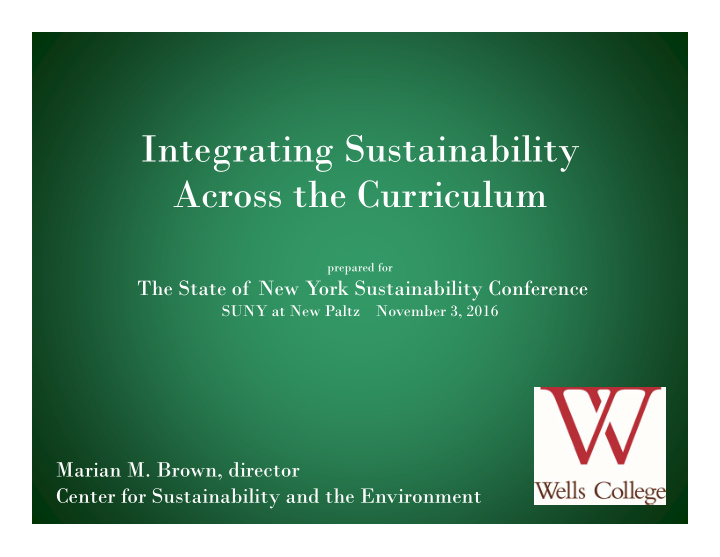



Integrating Sustainability Across the Curriculum prepared for The State of New York Sustainability Conference SUNY at New Paltz November 3, 2016 Marian M. Brown, director Center for Sustainability and the Environment
“Building a Pedagogical Toolbox: The Nuts and Bolts of Infusing Sustainability into Humanities and Social Science Courses” pp. 76 - 87 Sharon M. Meagher, Ph.D. Dean of Arts & Sciences, Widener University
Typology of Pedagogical Strategies for Infusing Sustainability into Courses Design new sustainability-themed courses Wider impact – creating institutional change (Re)cast central questions of the course in terms of sustainability Introduce curricular module(s) or units Thread questions/issues throughout Add or refocus service or experiential learning projects Introduce sustainability in parts of lectures Add some directed lectures or lessons Add new writing, research or project options Bring in classroom guests Add a field trip or site visit Focus on professional standards and sustainability Change classroom or laboratory practice(s) Develop co-curricular projects in conjunction with courses The hidden curriculum
Sustainability Literacy Assessment 30 question instrument – administered via SurveyMonkey Ohio State University instrument – only using 30 knowledge questions 10 questions each among three sustainability knowledge domains: Environmental knowledge • Social knowledge • Economic knowledge • Pre-testing: SUS 101 Intro to Sustainability (3 years experience) Psych 335 Psychology of Environmental Sustainability Econ 255 Economics of Globalization yet to be administered Post-testing: SUS 101 and Psych 335 survey to be repeated by same cohort in December
What is the most common cause of pollution of streams and rivers? Dumping of garbage by cities. Surface water running off yards, city streets, paved lots, and farm fields Litter near streams and rivers Waste dumped by factories Don’t know Which of the following is a renewable resource? Oil Iron ore Trees Coal Don’t know What is the most common reason that an animal species becomes extinct? Pesticides Habitat loss Hunting Climate Change Don’t know
Approximately how much of the oil used in the U.S. in 2010 was imported? 20% 50% 80% 90% Don’t know Many economists argue that electricity prices in the U.S. are too low because: They do not reflect the costs of pollution from generating the electricity Too many suppliers go out of business Electric companies have a monopoly in their service area Consumers spend only a small part of their income on energy Don’t know Which is the most commonly used definition of economic sustainability? Maximizing the share price of a company’s stock Long term profitability When costs equal revenue Continually expanding market share Don’t know
The wealthiest 20% of people in the U.S. own approximately what percent of the nation’s privately held wealth? 20% 35% 50% 85% Don’t know Over the past 3 decades, what has happened to the difference between the wealth of the richest and poorest Americans? The difference has increased The different has stayed about the same The difference has decreased Don’t know Approximately how many of the world’s 7 billion people go hungry or are malnourished? 10 million 100 million 1 billion 5 billion Don’t know
Fall 2014 – SUS 101 Introduction to Sustainability - 13 students Freshmen 18.75 average score Juniors 15.25 average score Seniors 19.2 average score (3 business, 1 natural science) Environmental Science major 19.25 average score Business majors 15.5 average score Fall 2015 – SUS 101 Introduction to Sustainability - 18 students Freshmen 19 average score (only 1) Sophomores 17.5 average score (only 2) Juniors 21.8 average score (3 nat science) Seniors 20.3 average score (6 natural science) Env/Natural Science major 22.0 average score Business majors 19.0 average score Fall 2016 – SUS 101 Introduction to Sustainability - 19 students Freshmen 20.14 average score (5) Sophomores 17.33 average score (3) Juniors 16.0 average score (3) Seniors 16.125 average score (8) Env/Natural Science majors 20.8 average score Business majors 19.0 average score
Fall 2016 – Introduction to Sustainability pre-test Questions most commonly answered correctly : Q6: Ozone forms a protective layer in the earth's upper atmosphere. What does ozone protect us from? (UV rays) 17/19 Q9: Which of the following household wastes is considered a hazardous waste? (batteries) 16/18 (one NR) Q27: Higher levels of education generally lead to (greater annual earnings) 17/19 Q1: There are many different kinds of animals and plants, and they live in many different types of environments. What is the word used to describe this idea? (Biodiversity) 16/19 Q24: Over the past 3 decades, what has happened to the difference between the wealth of the richest and poorest Americans? (The difference has increased) 16/19 Q7: Where does most of the garbage in the U.S. end up? (landfills) 14/19 Q8: What is the name of the primary federal agency that oversees environmental regulation? (EPA) 14/19 Q10: What is the most common reason that an animal species becomes extinct? (habitat loss) 14/19 Q18: Which of the following countries has now passed the U.S. as the biggest emitter of the greenhouse gas carbon dioxide? (China) 14/18 (one NR)
Fall 2016 – Introduction to Sustainability pre-test Questions most commonly answered IN correctly : Q19: Which of the following is the primary reason that gasoline prices have fallen lately in the U.S.? ( decreased global demand due to the prolonged economic stagnation ) 2/19 (Note: Econ professor Kent Klitgaard submitted alternate question to original Q19 due to current conditions). Q17: Approximately how much of the oil used in the U.S. in 2010 was imported from other countries? (50%) 4/19 Q16: If everybody on the planet consumed natural resources at the rate of the average American, approximately how many Earths would be needed to support humankind? (5 earths) 6/19 Q26: Approximately how many of the world's 7 billion people go hungry or are malnourished. (1 billion) 7/19 Q27: Which of the following populations has the highest growth rate? (Africa) 7/19 Q21: Which of the following is a leading cause of depletion of fish stocks in the Atlantic Ocean? (Fishermen seeking to maximize their catch) 7/19
Recommend
More recommend